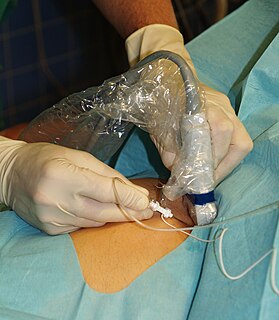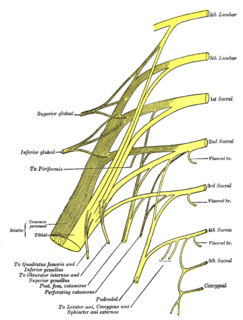| Sciatic nerve block | |
|---|---|
Nerves of the right lower extremity Posterior view |
A sciatic nerve block is a nerve block that uses local anesthetic to achieve analgesia in the leg. The block works by affecting the sciatic nerve and is used for surgeries at or below the knee. [1]

Local anesthetic nerve block is a short-term nerve block involving the injection of local anesthetic as close to the nerve as possible for pain relief. The local anesthetic bathes the nerve and numbs the area of the body that is innervated by that nerve. The goal of the nerve block is to prevent pain by blocking the transmission of pain signals from the surgical site. The block provides pain relief during and after the surgery. The advantages of nerve blocks over general anesthesia include faster recovery, monitored anesthesia care vs. intubation with an airway tube, and much less postoperative pain.

A leg is a weight-bearing and locomotive anatomical structure, usually having a columnar shape. During locomotion, legs function as "extensible struts". The combination of movements at all joints can be modeled as a single, linear element capable of changing length and rotating about an omnidirectional "hip" joint.

The sciatic nerve is a large nerve in humans and other animals. It begins in the lower back and runs through the buttock and down the lower limb. It is the longest and widest single nerve in the human body, going from the top of the leg to the foot on the posterior aspect. The sciatic nerve provides the connection to the nervous system for nearly the whole of the skin of the leg, the muscles of the back of the thigh, and those of the leg and foot. It is derived from spinal nerves L4 to S3. It contains fibers from both the anterior and posterior divisions of the lumbosacral plexus.
The sciatic nerve is located in the gluteus maximus muscle, where the block is performed. [1] The sciatic nerve can be blocked at different locations. At the popliteal fossa, the sciatic nerve divides into its two branches: The tibial and the common peroneal nerve. If surgery is performed on the ankle, achilles tendon or foot a popliteal block can be performed, affecting the two branches of the sciatic nerve. It is done above the knee on the [1] posterior leg where the sciatic nerve starts splitting into the common peroneal and tibial nerves. [1]

The tibial nerve is a branch of the sciatic nerve. The tibial nerve passes through the popliteal fossa to pass below the arch of soleus.
The common fibular nerve is a nerve in the lower leg that provides sensation over the posterolateral part of the leg and the knee joint. It divides at the knee into two terminal branches: the superficial fibular nerve and deep fibular nerve, which innervate the muscles of the lateral and anterior compartments of the leg respectively. When the common fibular nerve is damaged or compressed, foot drop can be the end result.
















